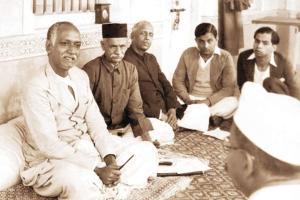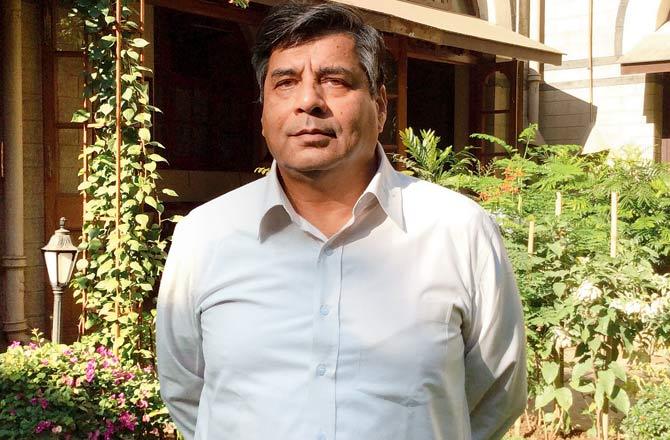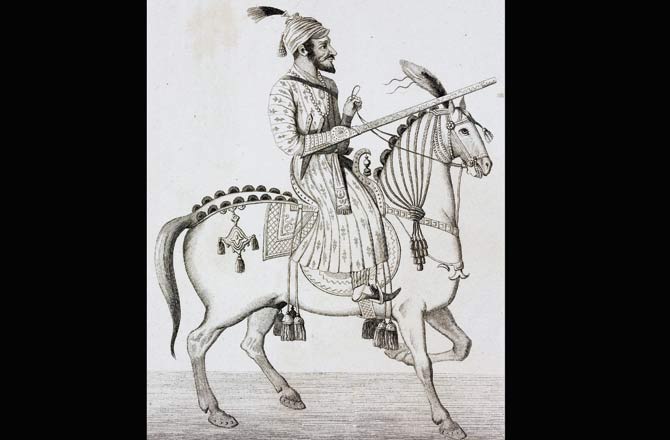Three 20th century researchers, who practically every history student follows, were close but didn't agree on everything. TCA Raghavan's latest book looks at Jadunath Sarkar, GS Sardesai, Raghubir Sinh's contribution to Indian history through prism

Jadunath Sarkar (extreme left) with GS Sardesai (in cap) at a meeting of Workers in Indian History at Kamshet, October 1938. Pics courtesy/ History Men, Harpercollins India
On Wikipedia, the name Balaji Yashwant Gulgule is conspicuous by its absence. A chief revenue collector for the Scindias in Kota, in the 1730s, Gulgule finds mention in TCA Raghavan's just-released non-fiction title, History Men (HarperCollins India). His family, over time "accumulated a range of functions as bankers and agents" for the Maratha chiefs. These correspondences grew into a huge mass of documents that provided an almost, accurate picture of the times of the ruling dynasty. Getting access to this collection becomes pivotal to Raghavan's work, which tells the story of the 20th century historian triad, Jadunath Sarkar, GS Sardesai and Raghubir Sinh and how their friendship nurtured their research.
The Gulgule documents were just one example of the prodigious joint efforts of Sarkar, Sardesai and Sinh to make history accessible and available to all. Following several exchanges with the owner of the Gulgule family collection, Sardar Pushottam Rao Gulgule, the trio was finally able to get hold of it. "But it embroiled them in a court case, which disallowed them from publishing these documents. The inability to publish meant that their quest was a failure. But, a copy was kept by Sinh in his library in Sitamau and it remains the one usually consulted today. The original is harder to track. The Sitamau copy had the added advantage of being edited and referenced by Sardesai," says Raghavan, former High Commissioner of India to Singapore and Pakistan.
 TCA Raghavan
TCA Raghavan
Raghavan got interested in these researchers, as a student, much before he decided to pursue a PhD in history from Jawaharlal Nehru University. "When I was an undergraduate in the 1970s and long before I had delved into their books, I chanced upon the Sarkar-Sardesai letters and then a little later, the Sarkar-Sinh correspondence. I found the close intellectual and personal relationship that these three men from different parts of the country established through a long drawn correspondence, fascinating," says Delhi based Raghavan, who works as director-general of the Indian Council of World Affairs, in an email interview.
The letters, he says, are fascinating because they evoke an age, which is now past—defined by railway timetables, postal mail and spending weeks, if not months, acquiring a book. "But the correspondence fully makes sense only when it is seen in the context of their books and other published works. So, the letters are like a long distance conversation in which ideas and arguments are refined, polished and occasionally discarded. But you also see, alongside, relationships getting formed."
 Shivaji Bhonsle’s (1627-1680) engraving by Lemaitre from Inde, by Dubois De Jancigny and Xavier Raymond, published by Firmin Didot Freres, Paris, 1845. Raghavan writes that Sarkar and Sardesai could never reconcile their fundamental differences on the Maratha ruler. Sinh was even more critical of the Marathas "because he saw them through the prism of Malwa and Rajput history". Pic/ Getty Images
Shivaji Bhonsle’s (1627-1680) engraving by Lemaitre from Inde, by Dubois De Jancigny and Xavier Raymond, published by Firmin Didot Freres, Paris, 1845. Raghavan writes that Sarkar and Sardesai could never reconcile their fundamental differences on the Maratha ruler. Sinh was even more critical of the Marathas "because he saw them through the prism of Malwa and Rajput history". Pic/ Getty Images
In their lifetime, Sarkar (1870-1958), who hailed from Dhaka, and Ratnagiri-born Sardesai (1865-1959), who studied at the Government Elphinstone College of Bombay, had exchanged thousands of letters—of these 625 by Sarkar and 770 of Sardesai were eventually preserved. Sinh, born in 1908, the scion and heir to the throne of the small princely state of Sitamau in Central India, became acquainted with the duo later in the 1930s. He was introduced to Sarkar as a possible D Litt student. Raghavan writes of how "an heir to a princely state wanting to write a serious research dissertation" was unusual, and is likely to have impressed Sarkar. "Sinh was younger so he had energy and youth when Sarkar and Sardesai were getting older. Plus, he had resources, as heir to a princely state. So he added great value. But I think both Sardesai and Sarkar—but especially the latter—saw Sinh as a vindication of their own efforts to write history for Indians. I do see Sinh as someone to whom the baton was passed by an older generation," he explains. Their association would continue for three decades.
Raghavan who has previously authored, The People Next Door: The Curious History of India's Relations with Pakistan (2017), began researching the trio in fits and starts, in 2015. "Over the years, I had collected a large trove of material and had a mental map of the kind of story I wanted to relate. I discovered a great deal of interesting detail whose obscurity makes it valuable. I liked the process of reconnecting long forgotten dots," says the historian. His notes and index, which runs into nearly 80 pages, offers a glimpse into this research. "The challenge was to make it into a story which would touch on the personal relationships and equally, their deep commitment to writing history objectively."
 Sarkar with Raghubir Sinh, December 1937
Sarkar with Raghubir Sinh, December 1937
Not all great minds, however, think alike. Raghavan shows how the three historians, despite being tight friends and contemporaries, approached and treated their subjects differently. A case in point, was Maratha ruler Chhatrapati Shivaji Maharaj. "In Sarkar's, view the scale of Shivaji's achievements was sufficiently great, so that it was unnecessary to romanticise him or his political struggles. Sardesai was more reverential because he felt that historians to date had not been fair to the Marathas." The two could never reconcile this fundamental difference. Sinh was even more critical of the Marathas "because he saw them through the prism of Malwa and Rajput history". "For me, the important point was not that they differed so fundamentally, but that despite these differences they worked together for so long as a team and put up a kind of united front against others," says the author.
Catch up on all the latest Mumbai news, crime news, current affairs, and also a complete guide on Mumbai from food to things to do and events across the city here. Also download the new mid-day Android and iOS apps to get latest updates
 Subscribe today by clicking the link and stay updated with the latest news!" Click here!
Subscribe today by clicking the link and stay updated with the latest news!" Click here!









